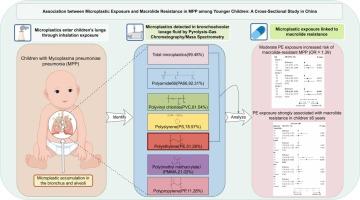Association between Microplastic Exposure and Macrolide Resistance in Mycoplasma pneumoniae pneumonia among Younger Children: A Cross-Sectional Study in China
IF 11.3
1区 环境科学与生态学
Q1 ENGINEERING, ENVIRONMENTAL
引用次数: 0
Abstract
Microplastics (MPs) are emerging environmental contaminants that pose potential health risks through inhalation, ingestion, and dermal contact. However, data on MP exposure and its impact on the pediatric respiratory system remain limited. This study aimed to assess MP levels in bronchoalveolar lavage fluid (BALF) and evaluate their associations with macrolide resistance in children with Mycoplasma pneumoniae pneumonia (MPP). BALF samples from 195 children aged 1-16 years were analyzed using Laser Direct Infrared (LDIR) spectroscopy and Pyrolysis-Gas Chromatography/Mass Spectrometry (Py-GC/MS). Six types of MPs were identified: Polyamide 66 (PA66) (92.31%), Polyvinyl Chloride (PVC) (81.54%), Polystyrene (PS) (78.97%), Polyethylene (PE) (51.28%), Polymethyl Methacrylate (PMMA) (21.02%), and Polypropylene (PP) (11.28%). MPs were detected in 194 out of 195 samples, with an overall detection rate of 99.48%. Logistic regression showed that moderate exposure to PE (0.32-1.05 µg/ml) significantly increased the odds of macrolide-resistant MPP compared to low exposure (OR = 1.39; 95% CI: 1.01-1.92; P < 0.05). Among children aged ≤6 years, high PE exposure was strongly associated with odds of macrolide-resistant MPP (OR = 2.62; 95% CI: 1.37-5.02; P < 0.05), with a significant dose-response trend (P trend = 0.004). These findings provide the first evidence linking lower respiratory tract MP exposure with antibiotic resistance in pediatric MPP, particularly among younger children, and underscore the importance of minimizing environmental MP exposure in vulnerable populations.

中国儿童肺炎支原体肺炎微塑料暴露与大环内酯类药物耐药性的关系:一项横断面研究
微塑料(MPs)是一种新兴的环境污染物,通过吸入、摄入和皮肤接触构成潜在的健康风险。然而,MP暴露及其对儿童呼吸系统影响的数据仍然有限。本研究旨在评估支气管肺泡灌洗液(BALF)中MP水平,并评估其与肺炎支原体肺炎(MPP)儿童大环内酯耐药的关系。采用激光直接红外光谱(LDIR)和热解-气相色谱/质谱(Py-GC/MS)对195例1 ~ 16岁儿童的BALF样品进行了分析。共鉴定出6种MPs:聚酰胺66 (PA66)(92.31%)、聚氯乙烯(PVC)(81.54%)、聚苯乙烯(PS)(78.97%)、聚乙烯(PE)(51.28%)、聚甲基丙烯酸甲酯(PMMA)(21.02%)和聚丙烯(PP)(11.28%)。195份样品中有194份检测到MPs,总检出率为99.48%。Logistic回归显示,与低暴露相比,中度暴露于PE(0.32-1.05µg/ml)显著增加大环内酯耐药MPP的几率(OR = 1.39; 95% CI: 1.01-1.92; P < 0.05)。在≤6岁的儿童中,高PE暴露与大环内酯耐药MPP的发生率密切相关(OR = 2.62; 95% CI: 1.37-5.02; P < 0.05),且有显著的剂量-反应趋势(P趋势= 0.004)。这些发现提供了将下呼吸道多氯丁酸暴露与儿科多氯丁酸抗生素耐药性联系起来的第一个证据,特别是在年幼儿童中,并强调了在易感人群中尽量减少环境多氯丁酸暴露的重要性。
本文章由计算机程序翻译,如有差异,请以英文原文为准。
求助全文
约1分钟内获得全文
求助全文
来源期刊

Journal of Hazardous Materials
工程技术-工程:环境
CiteScore
25.40
自引率
5.90%
发文量
3059
审稿时长
58 days
期刊介绍:
The Journal of Hazardous Materials serves as a global platform for promoting cutting-edge research in the field of Environmental Science and Engineering. Our publication features a wide range of articles, including full-length research papers, review articles, and perspectives, with the aim of enhancing our understanding of the dangers and risks associated with various materials concerning public health and the environment. It is important to note that the term "environmental contaminants" refers specifically to substances that pose hazardous effects through contamination, while excluding those that do not have such impacts on the environment or human health. Moreover, we emphasize the distinction between wastes and hazardous materials in order to provide further clarity on the scope of the journal. We have a keen interest in exploring specific compounds and microbial agents that have adverse effects on the environment.
 求助内容:
求助内容: 应助结果提醒方式:
应助结果提醒方式:


